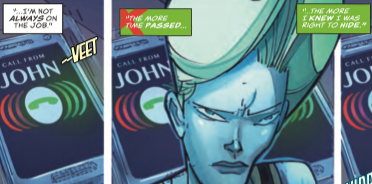Martian Manhunter #5 // Review
A displaced extra-terrestrial deals with a complicated echoing into a present life on earth in the fifth issue of the Martian Manhunter mini-series. Steve Orlando’s story continues to develop with artwork by Riley Rossmo. Color comes to the page courtesy of Ivan Plascencia. The story of a being caught between worlds shows some promise in Orlando’s script, but the immensely exaggerated arcs and curves of Plascencia’s artwork hold the emotionality of the story at a contorted distance that continues to stand in the way of the very emotion it seems to be attempting to bring to the page.
Martian criminal Char’nn Ozzm confronts J’onn J’onnz. The confrontation causes J’onnz to undergo a violent reaction that threatens his life. To survive, he’s going to need the aid of his fellow police officer Diane. She’s reluctant to heed his call having recently discovered that her longtime work partner has been hiding his true identity as The Martian Manhunter from her. And then there is, of course, the fact that she’s been hiding aspects of her own life from him. Secrets maintain as the ever-present threat of Char’nn persists in a psychological horror that fuses the past with the present in the troubled mind of J’onnz.
Orlando dives further into psychological horror with an extra-terrestrial who has adopted the identity of a human. The twin identities of former martian and current humanity are thrown together amidst revelation of lies and the sudden violent presence of the past. Orlando’s pacing of the story allows for a prolonged and agonizing dive into J’onnz’s inner conflicts as Char’nn tortures him with vivid memories of his own past, which contort his body. Contrasting this against Diane’s own personal life dilute the impact of the horror quite a bit, but the heart of the fear is quite clearly present in the story.
Rossmo’s art has been praised. It’s certainly distinctive. While the gloopy curves and exaggerations in form and anatomy resemble cheese-laden pasta more than anything approaching real human drama, there’s no doubting that Rossmo’s art would be instantly recognizable from across a crowded room or a busy intersection. Art that’ this distinctive does have a tendency to overpower a story and that’s precisely what it’s doing here. When the fantastic world of Mars in flashbacks doesn’t look significantly different from the more down-to-earth locations in the present tense, things feel far too amorphous. There isn’t a clear enough distinction between the two different ends of J’onzz’s identity to make the distorted contrast between the two to feel any more disorienting than any of the rest of the comic book. It all just feels like a big, soupy mess.
All criticism aside, the visuals that Rossmo is delivering to the page ARE quite memorable. The fact that they hijack the story that’s being rendered by Orlando is disappointing, but Rossmo’s art (which really IS beautiful in a soupy, formless, noodley sort of a way) definitely needs some sort of grounding to be effective. Orlando’s script might be just the sort of thing that Rossmo’s art needs to bind it to a coherent page. Too bad so much of the story gets lost in the process.










